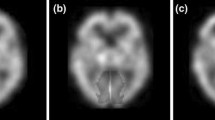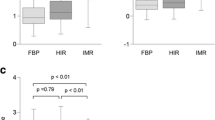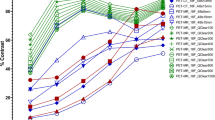Abstract
Purpose
The aim of this study was to evaluate the effect of ordered subsets maximization expectation (OSEM) and filtered backprojection (FBP) reconstruction algorithms for the qualitative interpretation of DAT-SPECT.
Methods
Data were acquired using an anthropomorphic striatal phantom and a gamma camera (SPECT/CT). Images were reconstructed using different values of the covariates applied in the OSEM and FBP algorithms (iteration, subsets, order, and cut-off frequency). Image quality was compared according to each set of covariates used in the reconstruction and extracted quantitative parameters of the image quality, such as C, CV RCR, and RSR, as well as the angular coefficients of the edges in regions of interest.
Results
Variations in the order from 0 to 10 do not influence the image if a trustworthy cut-off frequency range for FBP (0.9 to 1.6) and OSEM (1.2 to 1.5) are used. For OSEM, the iteration value and the number of subsets that guarantee better quality were those suggested by the developer of the algorithm used (3i8s).
Conclusion
For a quality image, it is necessary to use the range of values found for the covariables order and cut-off frequency of the Butterworth filter in the FBP and OSEM reconstruction. OSEM reconstruction shows superiority in the images compared with FBP when the recommended three iterations and eight subsets are used. In the quantitative analyses, the evaluation showed that increasing the number of updates while allowing a better distinction of certain areas, culminates with a degradation image, making it inappropriate for clinical.












Similar content being viewed by others
References
Alessio A, Sauer K, Kinahan P. Statistical image reconstruction from correlated data with applications to PET. Phys Med Biol. 2007;52:6133–50.
Alzimami KS, Sassi SA, Spyrou NM. A comparison between 3D OSEM and FBP image reconstruction algorithms in SPECT Lecture Notes in Electrical Engineering pp 195–206, 2009.
Brambilla M, Canillo B, Dominietto M. Characterization of ordered-subsets expectation maximization with 3d postreconstruction gauss filtering and comparison with filtered backprojection in99mTc SPECT. Ann Nucl Med. 2005;19:75.
Bourne R. Fundamentals of digital imaging in medicine. 2010.
Ceriani L, Ruberto T, Delaloye AB, Prior JO, Giovanella L. Three-dimensional ordered-subset expectation maximization iterative protocol for evaluation of left ventricular volumes and function by quantitative gated SPECT: a dynamic phantom study. J Nucl Med Technol. 2010;38:18–23.
Cherry SR, Sorenson JA, Phelps ME. Physics in nuclear medicine. Amsterdam: Elsevier Health Sciences; 2012.
Dickerson B. Neuroimagin, cerebrospinal fluid markers and genetic testing in dementia: comprehensive principles and pratices. Oxford: Oxford University Press; 2009.
Duarte DD, Monteiro MS, El Hakmaoui F, Prior JO, Vieira L, Pires-Jorge JA. Influence of reconstruction parameters during filtered backprojection and ordered-subset expectation maximization in the measurement of the left-ventricular volumes and function during gated SPECT. J Nucl Med Technol. 2012;40:29–36.
Fraquelli M, Rigamonti C, Casazza G, Conte D, Donato MF, Ronchi G, et al. Reproducibility of transient elastography in the evaluation of liver fibrosis in patients with chronic liver disease. Gut. 2007;56:968–73.
Gazewood JD, Richards DR, Clebak K. Parkinson disease: an update. Am Fam Physician. 2013;87:267–73.
Gonzalez RC, Woods RE. Digital image processing. Upper Saddle River: Prentice Hall; 2008.
Gutman F, Gardin I, Delahaye N. et al. Optimisation of the OS-EM algorithm and comparison with FBP for image reconstruction on a dual-head camera: a phantom and a clinical 18F-FDG study. Eur J Nucl Med Mol Imaging. 2003;30:1510–1519. https://doi.org/10.1007/s00259-003-1246-6.
Hsiao I-T, Weng Y-H, Lin W-Y, Hsieh C-J, Wey S-P, Yen T-C, et al. Comparison of 99mTc-TRODAT-1 SPECT and 18 F-AV-133 PET imaging in healthy controls and Parkinson’s disease patients. Nucl Med Biol. 2014;41:322–9.
Knoll P, Kotalova D, Köchle G, Kuzelka I, Minear G, Mirzaei S, et al. Comparison of advanced iterative reconstruction methods for SPECT/CT Z. Med Phys. 2012;22:58–69.
Koch W, Hamann C, Welsch J, Pöpperl G, Radau PE, Tatsch K. Is iterative reconstruction an alternative to filtered backprojection in routine processing of dopamine transporter SPECT studies? J Nucl Med. 2005;46:1804–11.
Koch W, Suessmair C, Tatsch K, Pöpperl G. Iterative reconstruction or filtered backprojection for semi-quantitative assessment of dopamine D2 receptor SPECT studies? Eur J Nucl Med Mol Imaging. 2011;38:1095–103.
Li D-H, Zhang L-Y, Hu Y-Y, Jiang X-F, Zhou H-Y, Yang Q, et al. Transcranial sonography of the substantia nigra and its correlation with DAT-SPECT in the diagnosis of Parkinson’s disease. Parkinsonism Relat Disord. 2015;21:923–8.
Liu H, Dong F, Meng Z, Zhang B, Tan J, Wang Y. Evaluation of Tourette’s syndrome by 99mTc-TRODAT-1 SPECT/CT imaging. Ann Nucl Med. 2010;24:515–21.
Morey AM, Kadrmas DJ. Effect of varying number of OSEM subsets on PET lesion detectability. J Nucl Med Technol. 2013;41:268–73.
Munhoz RP, Moro A, Silveira-Moriyama L, Teive HA. Non-motor signs in Parkinson’s disease: a review. Arq Neuropsiquiatr. 2015;73:454–62.
Pareto D, Cot A, Pavia J, et al. Iterative reconstruction with correction of the spatially variant fan-beam collimator response in neurotransmission SPET imaging. Eur J Nucl Med Mol Imaging. 2003;30:1322–29.
Powsner RA, Palmer MR, Powsner ER. Essentials of nuclear medicine physics and instrumentation. Wiley-Blackwell; 3 edition. 2013. https://doi.org/10.1002/9781118473481.
Seret A, Forthomme J. Comparison of different types of commercial filtered backprojection and ordered-subset expectation maximization SPECT reconstruction software. J Nucl Med Technol. 2009;37:179–87.
Shrout PE, Fleiss JL. Intraclass correlations: uses in assessing rater reliability. Psychol Bull. 1979;86:420–8.
Silva AMM, da Silva AMM. Reconstrução quantitativa de SPECT: avaliação de correções; 2012 Online: https://doi.org/10.11606/t.43.1998.tde-21062012-152027.
Winz OH, Hellwig S, Mix M, Weber WA, Mottaghy FM, Schäfer WM, et al. Image quality and data quantification in dopamine transporter SPECT: advantage of 3-dimensional OSEM reconstruction? Clin Nucl Med. 2012;37:866–71.
Yin T-K, Lee B-F, Yang YK, Chiu N-T. Differences of various region-of-interest methods for measuring dopamine transporter availability using 99mTc-TRODAT-1 SPECT. ScientificWorldJournal. 2014;2014:837439.
Acknowledgments
We also thank John Carpenter, Ribeirão Preto, Brazil, for the English revision.
Funding
The authors gratefully acknowledge financial support from: (a) Grant/Project No. 049/2013 (AUXPE No. 2880/2013) from CAPES/NUFFIC, Brazil Netherlands International Cooperation; (b) Grant No. 2013/25.987-2 and Grant No. 2015/50089-3 from The State of São Paulo Research Foundation (FAPESP). None of these funding agencies played a role in the design, data collection, management, analysis, interpretation of the data and preparation, review, or approval of the manuscript. We confirm that we have read the Journal’s position on issues involved in ethical publication and affirm that this report has the approval of our institutional ethics committee.
Author information
Authors and Affiliations
Corresponding author
Ethics declarations
Conflict of interest
The authors declare that they have no conflicts of interest.
Additional information
Publisher’s note
Springer Nature remains neutral with regard to jurisdictional claims in published maps and institutional affiliations.
Rights and permissions
About this article
Cite this article
Trevisan, A.C., Raed, M.D., Tumas, V. et al. Comparison between OSEM and FBP reconstruction algorithms for the qualitative and quantitative interpretation of brain DAT-SPECT using an anthropomorphic striatal phantom: implications for the practice. Res. Biomed. Eng. 36, 77–88 (2020). https://doi.org/10.1007/s42600-019-00034-x
Received:
Accepted:
Published:
Issue Date:
DOI: https://doi.org/10.1007/s42600-019-00034-x




